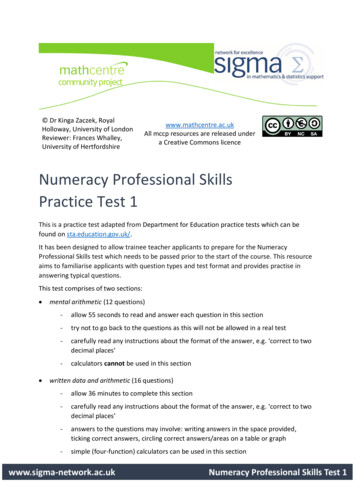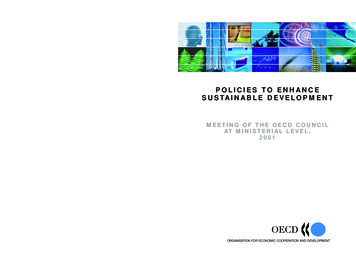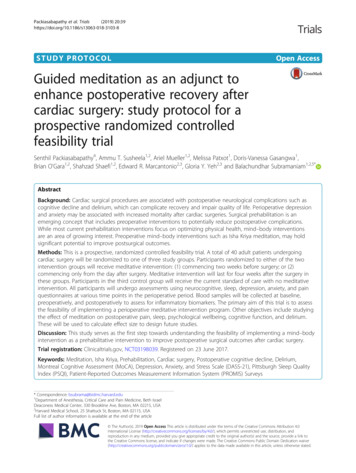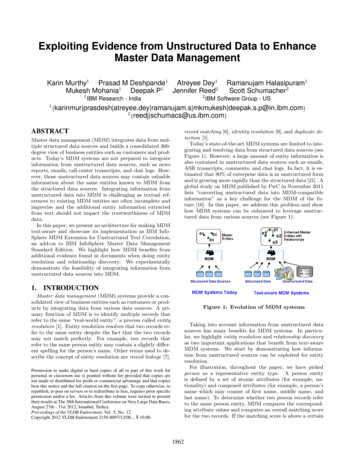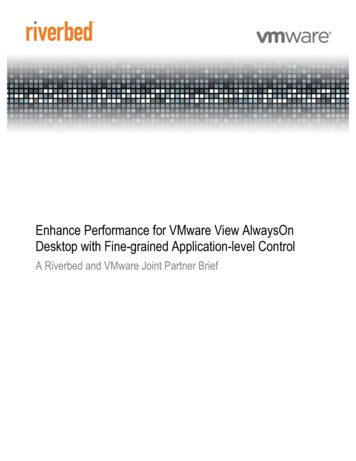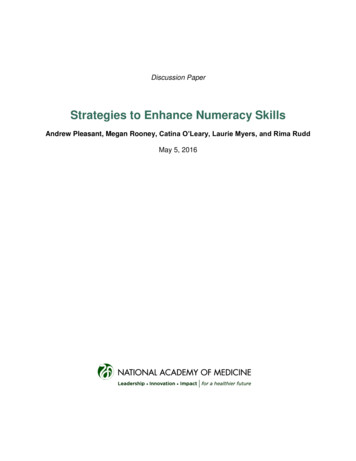
Transcription
Discussion PaperStrategies to Enhance Numeracy SkillsAndrew Pleasant, Megan Rooney, Catina O’Leary, Laurie Myers, and Rima RuddMay 5, 2016
Strategies to Enhance Numeracy SkillsAndrew Pleasant, Canyon Ranch Institute; Megan Rooney, Health Literacy Missouri;Catina O’Leary, Health Literacy Missouri; Laurie Myers, Merck & Co., Inc.; and RimaRudd, Harvard University1Individuals make decisions about health and well-being every day. Many of thosedecisions involve using and understanding numbers, and most of the decisions are made quickly,at home or at work, as a person goes about a daily routine. Even with adequate time, manypeople lack the skills to make good use of numerical information to help them make informeddecisions (Peters et al., 2014). Health professionals and health systems also often communicatenumerical information poorly, increasing the challenge (IOM, 2014).Like low health literacy (of which numeracy is a part), poor numeracy skills arewidespread and affect more than just those with lower income or less education. Factors such asemotional stress (perhaps from a recent diagnosis), lack of time or confidence, high demands fornumeracy skills, or simply a dislike of math can affect understanding, leading to people feeloverwhelmed (Peters et al., 2014).We aim in this paper to provide guiding principles for communicating numbers in a clear,simple way. These principles can be used by health professionals interacting with patients; healthsystems creating and giving information about diseases, treatments, prevention, cost, andcovered services; and health plans explaining the cost of deductibles, co-pays, maximum out-ofpocket costs, tiered coverage for medicines, and quality. Pharmaceutical and medical devicecompanies also have a great opportunity to explain the risks and benefits of medicines anddevices. No matter how different these organizations appear, they all should take the opportunityto help foster improved health decision making by presenting data and numbers clearly.An individual’s ability to understand and use numbers, such as data and risk information,to make health and health care decisions often depends on and can be greatly supported by theway numbers are presented (Zikmund-Fisher, 2013). Even those with higher numeracy skills arehelped by clear communication of numbers.The challenge is to know what numerical information to present (if any) and how topresent it so people can find, understand, evaluate, communicate, and use that information tomake an informed health decision. This capacity depends on many contextual factors, includingthe social and cultural setting, the audience, the purpose (to increase knowledge, instruct,facilitate decision making, or persuade), and the nature of the numerical information (is itfractions, percents, ratios, equations, and so forth). We believe that a complete understanding ofthose different contexts will help professionals choose the best way to communicate numericalinformation.STRATEGIESSeveral best practices are already well identified that can help make understandingnumerical information easier for all people to both understand and communicate (Peters et al.,2014; Trevena et al., 2013; Fischhoff et al., 2011; National Cancer Institute, 2011) . We offer thefollowing strategies to help make numerical information easier to communicate, less confusing,and easier to use.1The authors are participants in the activities of the Roundtable on Health Literacy working group on numeracy.1
Marry Words and Numbers to Provide a Complete UnderstandingWhen presenting numeric information (such as quantities, ratios, percentages, and soforth), emphasize numbers rather than words such as “rare,” “low risk,” or “common.” Suchwords have different meanings to people and can lead to confusion.However, neither words nor numbers are free from misinterpretation. Instead of replacingnumbers with words or words with numbers, use both when feasible to help people betterunderstand your message. This means ensuring that explanatory text accompanies the numbers,interprets their meaning, and gives descriptive information to place the numerical information incontext.Do the MathAlways do the math for your audience. For example, instead of advising people to lose acertain percentage of their body weight, which requires them to measure their weight and thencalculate a percentage, advise them to lose a precise number of pounds. By doing the math forthese individuals, you give them a specific action goal while not requiring them to performmathematics.To teach patients to calculate the percentage, use examples to illustrate the math. Forexample, a 100-pound person would need to lose 2 pounds to lose 2 percent of his or her weight,but a 200-pound person would need to lose 4 pounds to lose the same percent of his or herweight.Finally, if a quantity or rate might change over time, do that math for your audience aswell. For example, if a rate changes depending on income level, present the rates for severalincome categories so people can easily see how the rates change. Be specific about what causeschanges in risk and express the quantitative rates clearly.Be ConsistentUse consistent language and presentation styles and formats to help avoid confusion.Present numbers in consistent and expected formats—this further removes the burden ofperforming calculations and makes it easier to compare numbers. For example, use the samedenominators in fractions and ratios when comparing information—that is, compare “10 out of40” to “20 out of 40,” not to “10 out of 20.”Consistency is also important when providing information such as dosage instructions.What pharmacists write on the prescription label often vary, given the same prescription, andthese variations can cause patient confusion (Wolf et al., 2009).When possible, align your use of numbers with expected normative meaning—forexample, have higher numbers reflect “better” and lower numbers reflect a “worse” situation.Present Only the Most Necessary Information, But Enough to Be Fully UnderstoodProviding too much information can be overwhelming, especially to those with lowernumeracy and health literacy skills. Do not overwhelm people with numbers, but do give themall of what they need to make a truly informed decision. For example, to help people compare2
treatment options (for example, surgery versus chemotherapy versus palliative care, orchemotherapy alone versus chemotherapy plus radiation treatment), present only the mostimportant information related to the goal of this task—understanding and then choosing the besttreatment option. This means eliminating background information that is not directly relevant tothe choice.To help people make fully informed decisions, you also need to explain what informationyou have left out, why you left that information out, and where they can find it if they areinterested. Provide supporting information to help them easily find credible, accurate, andunderstandable additional information.Be Visual—Use Images and Shapes to Reflect the Meaning of the NumbersResearchers suggest giving people information in different ways, such as in verbal alongwith written or graphical form, to meet their preferred learning style and to ensureunderstandability. Providing information in graphical form using charts, pictographs, anddiagrams is particularly helpful.Combine numbers, words, and visuals to explain risk statements. Risk statements thatsolely rely on numbers may be difficult. People better understand probabilities when they arepresented with words and visuals that reinforce the meaning of the numbers rather than whennumbers are presented alone. Certain types of graphics in risk communication, such as iconarrays, bar charts, and risk scales can also be helpful.To help people manage their medicines, provide medication schedules, simple charts, oreven computer-aided tools to help people integrate multiple treatments and simplify dailyroutines. Be sure your visuals explain rather than confuse. For example, when using graphs andcharts to compare numerical information, be sure they are all presented in the same way, in thesame scale, and with the same labels and value ranges.Different types of visuals are better for communicating different concepts: Line graphs are usually better to explain trends over time than pie charts orbar graphs.Pie charts often show magnitude through an easy comparison of a part to thewhole.Bar charts can show magnitude and change over time or across groups.Maps allow geographic comparison.Pictographs or icon arrays can represent quantity while reflecting percentageof the whole.Finally, be very aware of your use of color and labels in visual presentations of numericinformation. People may assign meaning to a color (for example, red is often linked withdanger). Some people also have difficulty visually interpreting colors; contrast can often beuseful to help differentiate. Be sure your labels are understandable while being brief but alsorelevant and informative.Be Aware of How You Present or Describe a RiskTo make informed decisions, people need to understand the risks and benefits of3
behaviors, treatments, and preventive actions. When communicating about numbers that discussrisk, you are communicating about behaviors and their likely outcomes. That information will beinterpreted in many ways that include but go beyond a person’s numeracy skills.Be careful using percentages to explain changes in risk. For example, a change in riskfrom “1 in 100” to “2 in 100” is a 100 percent change, but using only that percent change ismisleading and may not lead to informed decision making. Furthermore, always explain what thepercentage is of, be it about people or objects or risk.Be extremely careful when comparing risk because even when the numbers areequivalent, the actual risk and the outcomes of that risk may not be equivalent. For example,when reporting change in two risk levels of 20 percent, if the baseline for one risk was 1 percent,that is an increase to 1.2 percent, but if the baseline for the second risk was 20 percent, thatwould be an increase to 25 percent. Furthermore, be very conscious of whether you aredescribing a risk or the level of dread or fear of that risk. Be very aware that people will interpreta risk based on many factors beyond the numbers—for example, how much they understand therisk, how much they dread or fear the risk, and how many people and which people may beaffected by the risk.Whether communicating relative or absolute risk, always be specific about who or whatthat risk is based on. Try to provide both absolute risk and relative risk. Absolute risk tells thelikelihood of something happening at all—it is the risk itself. The higher the absolute risk, themore likely it is that something will happen. Relative risk tells how much more or less likelysomething is compared to something else. This compares two risks—it tells you nothing aboutthe actual risk. Research shows that when only relative risk is presented, people may view risksas larger or treatments as worse. Providing absolute-risk information does the math for thereader, making the choices more concrete and requiring less cognitive effort and room for error.As much as possible, use both positive and negative frames to describe a risk. Forexample, “1 out of 10 women who take this medicine have side effects. This means that 9 out of10 women do not.” Some research suggests that when communicating risk, negative framing(“You have a 1 in 10 chance of dying”) can result in a desired behavior change more often. Onthe other hand, when promoting healthy preventive behaviors, positive framing (“Seat beltslower your chance of getting hurt in an accident”) may be more effective.Check In Early and OftenAlways take the time to test your communication with the intended audience. Involveyour audience early and often in message development—they are the experts in their own lifeand communication skills. During the communication, use methods such as teach-back to ensurethat your message is being understood as intended. Clearly explain your message and check infor comprehension as you do so. For example, when comparing two risks, the teach-back couldtake the form of a question such as, “I want to make sure I explained this well, so tell me, whichrisk did I say was higher of the two risks we’ve been talking about? Why is that risk higher?”CONCLUSIONNumeracy helps people in all walks of life—be they mathematical experts or third-gradestudents—to solve problems. One thing we can all agree on is that being alive inherently meansyou will encounter problems to be solved. These may be entirely numerical or about a risk you4
do not understand or a social or cultural situation you find perplexing. We close by proposingthat numeracy skills—both the skill to navigate numbers as well as the skill to successfullycommunicate numerical information—will be useful across the wide range of problems lifepresents. By making numbers and their implications more understandable to more people, wecan improve decision making, efficiency, and outcomes such as health and quality of life.Andrew Pleasant, Ph.D., is the senior director for health literacy and research at Canyon RanchInstitute. Megan Rooney, M.S.W., M.Ed., is the director of program development at HealthLiteracy Missouri. Catina O’Leary, Ph.D., L.M.S.W., is the president and chief executive officerof Health Literacy Missouri. Laurie Myers, M.B.A., is the global health literacy director atMerck & Co., Inc. Rima Rudd, Sc.D., M.S.P.H., is a senior lecturer on health literacy, education,and policy at the Harvard School of Public Health, Harvard University.5
REFERENCESFischhoff, B., N. Brewer, and J. Downs, eds. 2011. Communicating risks and benefits: Anevidence-based user’s guide. Washington, DC: Food and Drug sed March 31, 2016).IOM (Institute of Medicine). 2014. Health literacy and numeracy: Workshop summary.Washington, DC: The National Academies Press.National Cancer Institute. 2011. Making data talk: A library/MDT-Workbook.pdf (accessed March 31,2016).Peters, E., L. Meilleur, and M. K. Tompkins, eds. 2014. Numeracy and the Affordable Care Act:Opportunities and challenges. In Health literacy and numeracy: Workshop summary.Washington, DC: National Academies Press.Trevena, L. J., B. J. Zikmund-Fisher, A. Edwards, W. Gaissmaier, M. Galesic, P. K. Han, J.King, M. L. Lawson, S. K. Linder, I. Lipkus, E. Ozanne, E. Peters, D. Timmermans, andS. Woloshin. 2013. Presenting quantitative information about decision outcomes: A riskcommunication primer for patient decision aid developers. BMC Medical Informatics andDecision Making 13(Suppl 2):S7. http://doi.org/10.1186/1472-6947-13-S2-S7.Wolf, M. S., P. Shekelle, N. K. Choudhry, J. Agnew-Blais, R. M. Parker, and W. H. Shrank.2009. Variability in pharmacy interpretations of physician prescriptions. Medical Care47(3):370–373.Zikmund-Fisher, B. J. 2013. The right tool is what they need, not what we have: A taxonomy ofappropriate levels of precision in patient risk communication. Medical Care Research andReview 70(Suppl 1):37S–49S.Suggested CitationPleasant, A., M. Rooney, C. O’Leary, L. Myers, and R. Rudd. 2016. Strategies to enhancenumeracy skills. Discussion Paper, National Academy of Medicine, Washington, egies-to-Enhance-Numeracy-Skills.pdf.Disclaimer: The views expressed in this Perspective are those of the authors and not necessarily ofthe authors’ organizations or of the National Academy of Medicine (NAM). The Perspective isintended to help inform and stimulate discussion. It has not been subjected to the reviewprocedures of, nor is it a report of, the NAM or the National Academies of Sciences, Engineering,and Medicine. Copyright by the National Academy of Sciences. All rights reserved.6
following strategies to help make numerical information easier to communicate, less confusing, and easier to use. 1 The authors are participants in the activities of the
